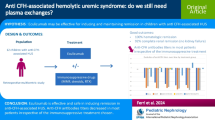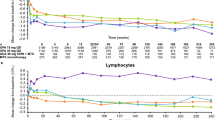Abstract
Renal dysfunction is a frequently encountered adverse event following treatment with high-dose interleukin-2 (IL-2). Information about parameters predicting the severity of IL-2-associated renal function abnormalities is limited. In this study the role of possible risk factors in the development of high-dose IL-2-associated acute and long-term renal dysfunction was investigated. A total of 72 patients, who were treated with a regimen consisting of IL-2 (18 MIU m−2 day−1 by continuous infusion), interferon α (IFNα; 5 MIU m−2 day−1, intramuscularly) and lymphokine-activated killer (LAK) lymphocytes, were analysed. Serum creatinine measurements were performed daily during treatment, weekly between courses and monthly during follow-up. Pre-and posttreatment 24-h urine samples were collected for calculation of creatinine clearances. Renal dysfunction was observed in 97% of patients. Grade 1 dysfunction (according to WHO criteria) was observed in 20 patients (28%), grade 2 in 37 (51%), grade 3 in 13 (14%) and grade 4 in 0 (0%). Renal dysfunction was reversible in more than 90% of patients. Only 6 patients (8%) suffered a certain amount of permanent function loss. More severe acute renal dysfunction occurred in patients who were experiencing hypertension prior to treatment, those who suffered sepsis during treatment and in men than in women. Sepsis was also associated with irreversible function loss. Other variables such as age, performance status, diabetes mellitus, interval between nephrectomy and start of IL-2 therapy and hypotension during treatment were not important. In conclusion, with high-dose IL-2, renal dysfunction develops in almost every patient and such abnormalities are mostly reversible. Predictors for severe acute renal dysfunction are pre-existing hypertension, sepsis and sex. A septic episode also carries a risk of permanent damage.
Similar content being viewed by others
Author information
Authors and Affiliations
Additional information
Received: 10 December 1998 / Accepted: 20 May 1999
Rights and permissions
About this article
Cite this article
Kruit, W., Schmitz, P. & Stoter, G. The role of possible risk factors for acute and late renal dysfunction after high-dose interleukin-2, interferon α and lymphokine-activated killer cells. Cancer Immunol Immunother 48, 331–335 (1999). https://doi.org/10.1007/s002620050582
Issue Date:
DOI: https://doi.org/10.1007/s002620050582




